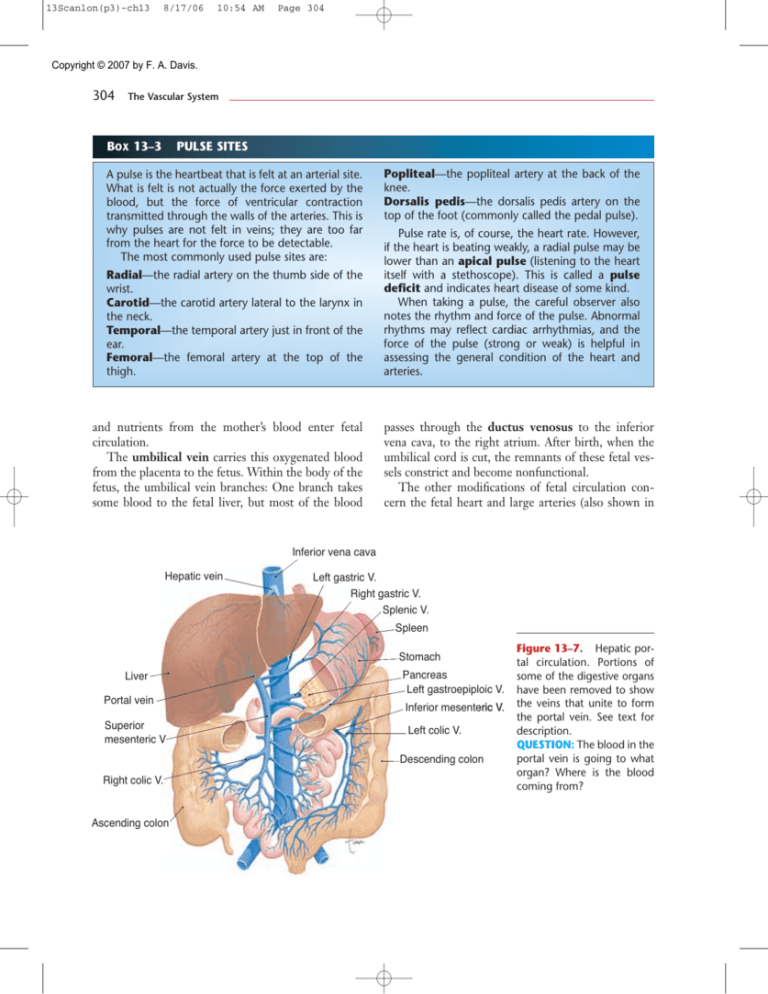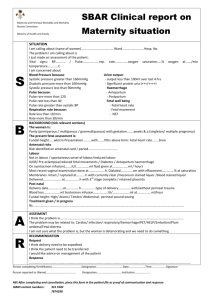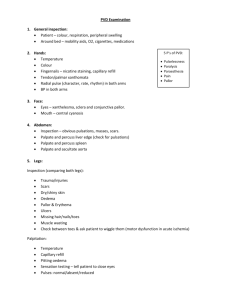and nutrients from the mother's blood enter fetal circulation. The
advertisement

13Scanlon(p3)-ch13 8/17/06 10:54 AM Page 304 Copyright © 2007 by F. A. Davis. 304 The Vascular System BOX 13–3 PULSE SITES A pulse is the heartbeat that is felt at an arterial site. What is felt is not actually the force exerted by the blood, but the force of ventricular contraction transmitted through the walls of the arteries. This is why pulses are not felt in veins; they are too far from the heart for the force to be detectable. The most commonly used pulse sites are: Radial—the radial artery on the thumb side of the wrist. Carotid—the carotid artery lateral to the larynx in the neck. Temporal—the temporal artery just in front of the ear. Femoral—the femoral artery at the top of the thigh. and nutrients from the mother’s blood enter fetal circulation. The umbilical vein carries this oxygenated blood from the placenta to the fetus. Within the body of the fetus, the umbilical vein branches: One branch takes some blood to the fetal liver, but most of the blood Popliteal—the popliteal artery at the back of the knee. Dorsalis pedis—the dorsalis pedis artery on the top of the foot (commonly called the pedal pulse). Pulse rate is, of course, the heart rate. However, if the heart is beating weakly, a radial pulse may be lower than an apical pulse (listening to the heart itself with a stethoscope). This is called a pulse deficit and indicates heart disease of some kind. When taking a pulse, the careful observer also notes the rhythm and force of the pulse. Abnormal rhythms may reflect cardiac arrhythmias, and the force of the pulse (strong or weak) is helpful in assessing the general condition of the heart and arteries. passes through the ductus venosus to the inferior vena cava, to the right atrium. After birth, when the umbilical cord is cut, the remnants of these fetal vessels constrict and become nonfunctional. The other modifications of fetal circulation concern the fetal heart and large arteries (also shown in Inferior vena cava Hepatic vein Left gastric V. Right gastric V. Splenic V. Spleen Stomach Liver Portal vein Superior mesenteric V Pancreas Left gastroepiploic V. Inferior mesenteric V. Left colic V. Descending colon Right colic V. Ascending colon Figure 13–7. Hepatic portal circulation. Portions of some of the digestive organs have been removed to show the veins that unite to form the portal vein. See text for description. QUESTION: The blood in the portal vein is going to what organ? Where is the blood coming from?








